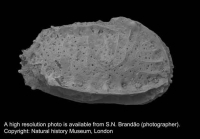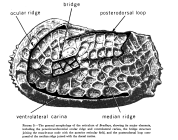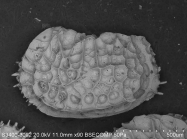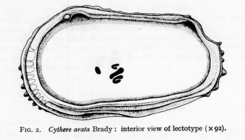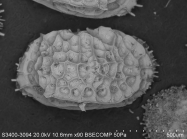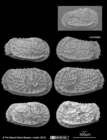RAS taxon details
Bradleya Hornibrook, 1952
391267 (urn:lsid:marinespecies.org:taxname:391267)
accepted
Genus
- Species Bradleya antarctica Hartmann, 1989
- Species Bradleya claudiae Jellinek & Swanson, 2003
- Species Bradleya cupa Jellinek & Swanson, 2003
- Species Bradleya glabra Jellinek & Swanson, 2003
- Species Bradleya johnsoni Benson & Peypouquet, 1983
- Species Bradleya mesembrina Mazzini, 2005
- Species Bradleya opima Swanson, 1979
- Species Bradleya pelasgica Whatley, Downing, Kesler & Harlow, 1984
- Species Bradleya silentium Jellinek & Swanson, 2003
- Species Bradleya thomasi Steineck & Yozzo, 1988
marine, brackish, fresh, terrestrial
recent + fossil
Hornibrook, N. B. (1952). Tertiary and recent marine Ostracoda of New Zealand, their origin affinities and distribution. <em>New Zealand Geological Survey, Paleontological Bulletin.</em> 18: 1-82. [details] Available for editors 
Brandão, S. N.; Antonietto, L. S.; Pereira, J. S.; Pereira, S. G. G.; Sá, H. A. B.; Praxedes, R. A.; Sabater, L. M., Santos, S.G.; Karanovic, I. (2025). World Ostracoda Database. Bradleya Hornibrook, 1952. Accessed through: RAS (Eds.) (2025) Register of Antarctic Species at: https://ras.biodiversity.aq/aphia.php?p=taxdetails&id=391267 on 2025-09-12
RAS (Eds.) (2025). Register of Antarctic Species. Bradleya Hornibrook, 1952. Accessed at: https://ras.biodiversity.aq/aphia.php?p=taxdetails&id=391267 on 2025-09-12
Date
action
by
original description
Hornibrook, N. B. (1952). Tertiary and recent marine Ostracoda of New Zealand, their origin affinities and distribution. <em>New Zealand Geological Survey, Paleontological Bulletin.</em> 18: 1-82. [details] Available for editors 
redescription Benson, R.H. (1972). The <i>Bradleya</i> Problem, with descriptions of two new psychrospheric ostracode genera, <i>Agrenocythere</i> and <i>Poseidonamicus</i> (Ostracoda: Crustacea). <em>Smithsonian Contributions to Paleobiology.</em> (12), 1-138., available online at http://si-pddr.si.edu/jspui/handle/10088/1879 [details] Available for editors
redescription Benson, R.H. (1972). The <i>Bradleya</i> Problem, with descriptions of two new psychrospheric ostracode genera, <i>Agrenocythere</i> and <i>Poseidonamicus</i> (Ostracoda: Crustacea). <em>Smithsonian Contributions to Paleobiology.</em> (12), 1-138., available online at http://si-pddr.si.edu/jspui/handle/10088/1879 [details] Available for editors
 Present
Present  Inaccurate
Inaccurate  Introduced: alien
Introduced: alien  Containing type locality
Containing type locality
